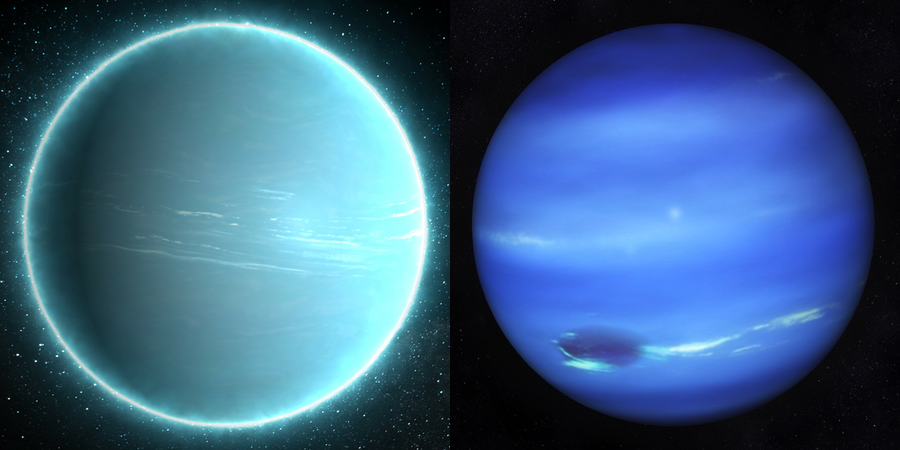One Model to Describe Them All—Well, Ice Giants Anyway
When it comes to space missions, the focus has largely lain with planets close to Earth, with those farther afield being left out in the cold. But that is about to change with a dedicated mission to Uranus slated for the 2030s. Scientists say that this trip will help them better understand the atmospheres of both Uranus and Neptune, our Solar System’s two ice giants–cold gas behemoths composed mostly of elements heavier than hydrogen and helium. Now, Patrick Irwin from the University of Oxford, UK, and colleagues have, for the first time, simultaneously analyzed the reflectance spectra of both ice giants using the same model [1]. In doing so, the team made two serendipitous discoveries about the visual appearances of both worlds, unlocking the reason why they shimmer in different hues of blue and why Neptune has dark spots. The team says that the findings could have implications for the study of the atmospheres of planets beyond our Solar System.
While there have been no previous stand-alone missions to Uranus and Neptune, the planets have not been completely ignored. For example, as NASA’s Voyager 2 passed by the ice giants in the late 1980s, it collected information about the reflectance of both worlds. Then in 1994, the Hubble Space Telescope captured its first images of the planets’ icy exteriors.
Most of the data collected from these and other ground-based observations look at small spectral regions of the light that Uranus and Neptune reflect and emit. This limited data makes it difficult for researchers to determine the properties of certain aerosol particles in the planets’ atmospheres. This problem is particularly acute for Neptune because its small size in the sky makes it hard to collect the longer wavelengths that the planet emits.
To solve that issue, Irwin and colleagues adapted a model that has previously been used to explore the reflectance spectra of nearly every other planet in our Solar System, as well as a few exoplanets. They adapted the model to work over a wide wavelength range, from 0.3 to 2.5 . The team then used the model to simultaneously analyze available observational data for both ice giants.
The team’s analysis reveals the presence of what they believe to be hydrocarbon-based aerosols high up in the stratospheres of both Uranus and Neptune. These particles fall through the planets’ atmospheres, mixing and reacting with gas, such as methane, that is simultaneously moving up. This process creates a haze around each planet. The team shows that Neptune’s atmosphere is more dynamic, giving Neptune a thinner haze—and darker hue—than Uranus. The team also finds that these aerosols could also be behind Neptune’s previously unexplained dark spots. After interacting with methane, the aerosols then meet hydrosulfide, which resides deeper in both Neptune’s and Uranus’ atmospheres. The team thinks the dark spots develop in places on Neptune that have a lower density of this material, with the patchiness coming from the dynamics of its enveloping gas.
Understanding the atmospheres of ice giants could be important for future exoplanet research, as it’s possible that this planet type is among the most abundant in the Milky Way, says Erich Karkoschka, a planetary researcher at the University of Arizona. That thinking comes because, to date, most of the exoplanets that have been found in our Galaxy have masses on the order of those of Uranus and Neptune.
Karkoschka notes that because Uranus and Neptune have such similar sizes, masses, and compositions, Irwin and his colleagues were able to fit their data with the same model, but it’s unlikely that a similar analysis could be done with any other two of our Solar System’s planets. That ability has implications for characterizing other ice giants. “If you had one [model] for Uranus and a different one for Neptune, then you wouldn’t know which to use” for another ice giant, he says. But, since this model works for both planets, he thinks there is “validity” in putting it to use on related systems.
–Allison Gasparini
Allison Gasparini is a freelance science writer based in Santa Cruz, CA.
References
- P. G. J. Irwin et al., “Hazy blue worlds: A holistic aerosol model for Uranus and Neptune, including dark spots,” JGR Planets 127 (2022).





